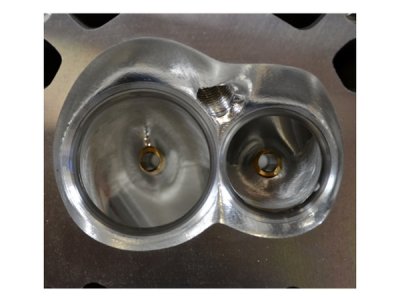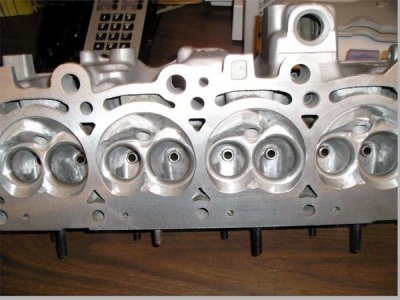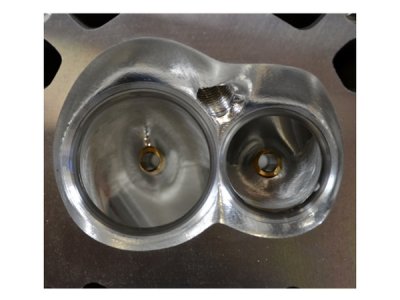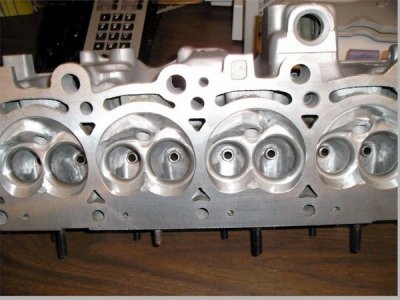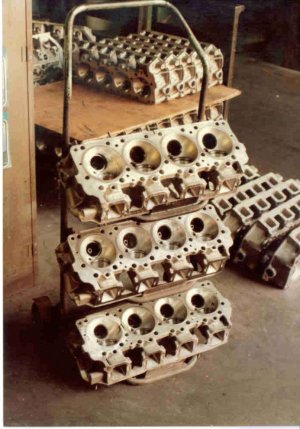- Joined
- Oct 20, 2014
- Messages
- 159
My goal is to CNC port the cylinder head for the 2.2/2.5 Chrysler 4 cylinder k-car from the 80's and 90's.
I have broken this down into a few steps:
Step 1. Make silicone mold of ports and combustion chamber (silicone off ebay for about $40)
Step 2. Scan molds using laser scanner (DAVID scanner + barcode laser line generator)
Step 3. Create 3D model of mold scans using Geomagic and Solidworks
Step 4. Use 3D model as a guide to create a custom combustion chamber and intake/exhaust runners
Step 5. Use Camworks to create toolpaths and machine cylinder head runners and CC on 3 axis using a few fixed setups.
So far I've gotten to step 5, but only for a small part of the combustion chamber.
I believe that using all the CAD and CAM software tools, you could reach all required internal geometry on the head using just a 3 axis mill with a couple fixed setups.
The CAD and CAM software do their job and help you figure out how to get to all the surfaces on a 3 axis with minimal setups.
If you take your average cylinder head, and say a 3/8" rod, you can see that most of the surfaces are visible from one perspective. Now add a few more vantage points and a tool that can undercut like a spherical ball mill or just a ball mill with a reduced shank, and you can get to 100% of them, at least on this head.
So I think this can be done on a 3 axis with minimal additional setups.
Keep in mind that the scans of the head only function as guides. Whatever design you want for the CC and runners gets drawn up in Solidworks from scratch, and you can use the existing stock surfaces to help you figure out how far you are straying from existing geometry. The only critical scanned locations are things like the valve seat centers, valve guide, planes at the head gasket and intake manifold gasket surfaces, etc..in other words, things that are machined can act as datums. You cant use the cast surfaces as datums because of core shift. Besides, we arent here to keep the existing surfaces, we're here to destroy them MUHAHAHAH
Heres what I've done so far:






































I have broken this down into a few steps:
Step 1. Make silicone mold of ports and combustion chamber (silicone off ebay for about $40)
Step 2. Scan molds using laser scanner (DAVID scanner + barcode laser line generator)
Step 3. Create 3D model of mold scans using Geomagic and Solidworks
Step 4. Use 3D model as a guide to create a custom combustion chamber and intake/exhaust runners
Step 5. Use Camworks to create toolpaths and machine cylinder head runners and CC on 3 axis using a few fixed setups.
So far I've gotten to step 5, but only for a small part of the combustion chamber.
I believe that using all the CAD and CAM software tools, you could reach all required internal geometry on the head using just a 3 axis mill with a couple fixed setups.
The CAD and CAM software do their job and help you figure out how to get to all the surfaces on a 3 axis with minimal setups.
If you take your average cylinder head, and say a 3/8" rod, you can see that most of the surfaces are visible from one perspective. Now add a few more vantage points and a tool that can undercut like a spherical ball mill or just a ball mill with a reduced shank, and you can get to 100% of them, at least on this head.
So I think this can be done on a 3 axis with minimal additional setups.
Keep in mind that the scans of the head only function as guides. Whatever design you want for the CC and runners gets drawn up in Solidworks from scratch, and you can use the existing stock surfaces to help you figure out how far you are straying from existing geometry. The only critical scanned locations are things like the valve seat centers, valve guide, planes at the head gasket and intake manifold gasket surfaces, etc..in other words, things that are machined can act as datums. You cant use the cast surfaces as datums because of core shift. Besides, we arent here to keep the existing surfaces, we're here to destroy them MUHAHAHAH
Heres what I've done so far:








































